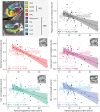Association of Sleep-Disordered Breathing and Medial Temporal Lobe Atrophy in Cognitively Unimpaired Amyloid-Positive Older Adults
- PMID: 37258299
- PMCID: PMC10435067
- DOI: 10.1212/WNL.0000000000207421
Association of Sleep-Disordered Breathing and Medial Temporal Lobe Atrophy in Cognitively Unimpaired Amyloid-Positive Older Adults
Abstract
Background and objectives: Sleep disordered breathing (SDB) has been related to amyloid deposition and an increased dementia risk. However, how SDB relates to medial temporal lobe neurodegeneration and subsequent episodic memory impairment is unclear. Our objective was to investigate the impact of amyloid positivity on the associations between SDB severity, medial temporal lobe subregions, and episodic memory performance in cognitively unimpaired older adults.
Methods: Data were acquired between 2016 and 2020 in the context of the Age-Well randomized controlled trial of the Medit-Aging European project. Participants older than 65 years who were free of neurologic, psychiatric, or chronic medical diseases were recruited from the community. They completed a neuropsychological evaluation, in-home polysomnography, a Florbetapir PET, and an MRI, including a specific high-resolution assessment of the medial temporal lobe and hippocampal subfields. Multiple linear regressions were conducted to test interactions between amyloid status and SDB severity on the volume of MTL subregions, controlling for age, sex, education, and the ApoE4 status. Secondary analyses aimed at investigating the links between SDB, MTL subregional atrophy, and episodic memory performance at baseline and at a mean follow-up of 20.66 months in the whole cohort and in subgroups stratified according to amyloid status.
Results: We included 122 cognitively intact community-dwelling older adults (mean age ± SD: 69.40 ± 3.85 years, 77 women, 26 Aβ+ individuals) in baseline analyses and 111 at follow-up. The apnea-hypopnea index interacted with entorhinal (β = -0.81, p < 0.001, pη2 = 0.19), whole hippocampal (β = -0.61, p < 0.001, pη2 = 0.10), subiculum (β = -0.56, p = 0.002, pη2 = 0.08), CA1 (β = -0.55, p = 0.002, pη2 = 0.08), and DG (β = -0.53, p = 0.003, pη2 = 0.08) volumes such that a higher sleep apnea severity was related to lower MTL subregion volumes in amyloid-positive individuals, but not in those who were amyloid negative. In the whole cohort, lower whole hippocampal (r = 0.27, p = 0.005) and CA1 (r = 0.28, p = 0.003) volumes at baseline were associated with worse episodic memory performance at follow-up.
Discussion: Overall, we showed that SDB was associated with MTL atrophy in cognitively asymptomatic older adults engaged in the Alzheimer continuum, which may increase the risk of developing memory impairment over time.
Trial registration information: ClinicalTrials.gov Identifier: NCT02977819.
Copyright © 2023 The Author(s). Published by Wolters Kluwer Health, Inc. on behalf of the American Academy of Neurology.
Conflict of interest statement
The authors report no relevant disclosures. Go to
Figures


References
Publication types
MeSH terms
Substances
Associated data
Grants and funding
LinkOut - more resources
Full Text Sources
Medical
Miscellaneous
